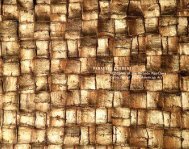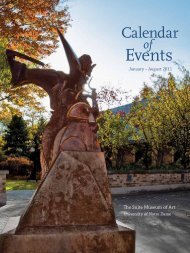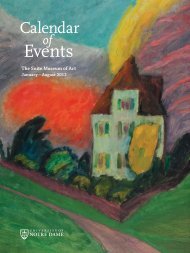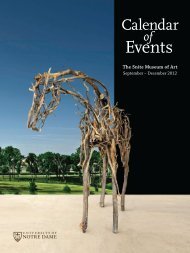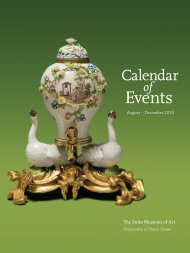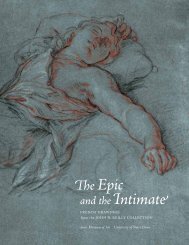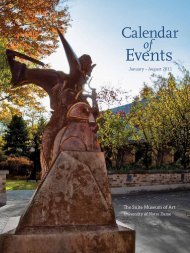HISTORY INTO ART AND ANTHROPOLOGY - Snite Museum of Art ...
HISTORY INTO ART AND ANTHROPOLOGY - Snite Museum of Art ...
HISTORY INTO ART AND ANTHROPOLOGY - Snite Museum of Art ...
You also want an ePaper? Increase the reach of your titles
YUMPU automatically turns print PDFs into web optimized ePapers that Google loves.
An essential part <strong>of</strong> a man’s armament was his warhorse, specially trained to remain<br />
steady under fire, to ride down fallen enemies without shying, and to respond to<br />
knee pressure alone, leaving the rider’s hands free for weaponry. Although wealthy<br />
men might own many horses, each warrior favored a single mount. Acknowledging<br />
the benefit <strong>of</strong> this close association, the U.S. Army encouraged scouts to provide<br />
their own mounts, paying them an additional allowance for their use. In the various<br />
scenes on this muslin as well as on White Swan’s many other works, he nearly<br />
always shows himself riding either a red or a yellow horse; these may represent the<br />
only horses <strong>of</strong> his war career, which perhaps lasted fewer than ten years. He rode<br />
the yellow steed at the Little Big Horn, where it was killed. The red, perhaps a bay,<br />
probably was his war mount during his youth.<br />
The simplicity with which White Swan represents himself stands in marked<br />
contrast to the detail he lavishes upon the figures <strong>of</strong> his opponents. Several wear<br />
feathered war bonnets, the flaring headdress that originated among the Lakota<br />
and was adopted as an insignia <strong>of</strong> honor by tribes across the Central Plains. Two<br />
enemy warriors are shown carrying shields, a part <strong>of</strong> their war medicine that they<br />
invoked for protection in battle. Both headdresses and shields attest to the prestige<br />
<strong>of</strong> these adversaries and, therefore, the honor <strong>of</strong> victory over them. White Swan<br />
paid particular attention to depicting the details <strong>of</strong> enemy dress and adornment—<br />
including coats with sides <strong>of</strong> different-colored cloth, elaborate beadwork designs on<br />
the leggings, and horses with painted faces and complex bridle fittings.<br />
The most exquisite individual shown is the warrior in figure 13. Besides displaying<br />
a painted shield with a feathered cloth drape hanging below and an eagle-feather<br />
war bonnet, he wears a beautiful shirt. It is fashioned from green wool cloth, with<br />
panels <strong>of</strong> red and white quillwork or beadwork adorning the front and the sleeves.<br />
Attached to these are rows <strong>of</strong> ermine-skin pendants, shown flying outward; the<br />
black tail tips <strong>of</strong> the skins stand out against the white fur <strong>of</strong> the winter pelt. Bits <strong>of</strong><br />
red cloth tied to the pendants on the right side <strong>of</strong> the shirt accentuate the contrast.<br />
White Swan was clearly remembering and savoring the details <strong>of</strong> his encounters<br />
with specific enemies.<br />
White Swan repeatedly depicted certain scenes in the paintings he made over the<br />
years. Although he never drew them in exactly the same way twice, he included key<br />
elements that mark them as the same event. The Lindesmith muslin includes two<br />
such recurrent vignettes (figs. 11 and 13). The first appears in no fewer than eleven<br />
<strong>of</strong> his works, and the second at least six times; they must have been <strong>of</strong> particular<br />
importance to the artist, who usually positioned them prominently within the larger<br />
array <strong>of</strong> events. In the muslin, they appear at the top, one above the other.<br />
In the scene that appears most <strong>of</strong>ten (fig. 11), White Swan shows himself mounted<br />
on the red horse, suggesting that the event occurred early in his war career. One<br />
might speculate that this image portrays his first coup, a crucial milestone in the life<br />
<strong>of</strong> a young warrior. Men who went on to win many battlefield honors always spoke<br />
proudly <strong>of</strong> their first publicly recognized deeds, <strong>of</strong>ten achieved when they were<br />
in their teens. White Swan shows himself facing a bonneted enemy armed with a<br />
pistol and with a rifle that evidently is not working, perhaps because it is jammed<br />
Fig. 11: Scene from AA1963.009.005; SMA, UND<br />
Fig. 12: Scene from AA1963.009.005; SMA, UND<br />
Fig. 13: Scene from AA1963.009.005; SMA, UND<br />
60 61



